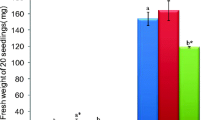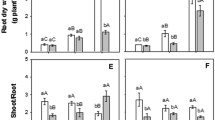Abstract
The comparative alterations of short term NaCl stress and recovery on growth, water relations, ionic composition, lipid peroxidation and antioxidants in roots of two rice cultivars differing in salt tolerance were studied. Exposed for 24 h to increasing (50, 100 and 150 mmol l−1) concentrations of NaCl, roots of 12D Oryza sativa L. cv. Lunishree and cv. Begunbitchi decreased in fresh weight, dry weight and relative water content. Increased Na+ and decreased K+ ion were determined at increasing NaCl concentrations. Both peroxide content and lipid peroxidation measured in terms of MDA level increased and the ratio was higher in Begunbitchi compared to Lunishree. Recovered roots showed lower peroxide and MDA content. Ascorbate and glutathione contents increased in the stressed and recovered roots of Lunishree, but decreased in Begunbitchi with increasing NaCl concentrations. Although SOD, CAT and GR activities decreased in the stressed roots, CAT activity also increased in recovered roots of both the cultivars. The POX activity increased in stressed and recovered roots of both Lunishree and Begunbitchi. Higher free radicals scavenging capacity and more efficient protection mechanism of Lunishree against salt stress, as revealed by the lower level of lipid peroxidation and improved plant water status as well as activities of some of the antioxidants, suggest that significant cultivar differences in response to salt stress in rice are closely related to differences in the activities of antioxidants and ion content. Another possible conclusion is that improved tolerance to salt stress may be accomplished by increased capacity of antioxidative system.




Similar content being viewed by others
Abbreviations
- AOS:
-
active oxygen species
- CAT:
-
catalase
- GR:
-
glutathione reductase
- MDA:
-
malondialdehyde
- NBT:
-
nitrobluetetrazolium
- POX:
-
peroxidase
- RWC:
-
relative water content
- TCA:
-
trichloroacetic acid
- TBA:
-
thiobarbituric acid
- SOD:
-
superoxide dismutase
- W i :
-
initial fresh weight
- W d :
-
dry weight
- W f :
-
turgid weight
References
Acar O, Turkan I, Ozdemir F (2001) Superoxide dismutase and peroxidase activites in drought sensitive and resistant barley (Hordeum vulgare L.) cultivars. Acta Physiol Plant 23:351–356
Al-Karaki GN (2000) Growth, water use efficiency, and sodium and potassium acquisition by tomato cultivars grown under salt stress. J Plant Nutr 23:1–8
Alscher RG, Erturk N, Heath LS (2002) Role of superoxide dismutases (SODs) in controlling oxidative stress in plants. J Exp Bot 53:1331–1341
Bor M, Ozdemir F, Turkan I (2003) The effect of salt stress on lipid peroxidation and antioxidants in leaves of sugar beet Beta vulgaris L. and wild beet Beta maritima L. Plant Sci 164:77–84
Chance B, Maehly AC (1955) Assay of catalase and peroxidase. Methods Enzymol 2:764–775
Demiral T, Turkan I (2005) Comparative lipid peroxidation, antioxidant defense systems and proline content in roots of two rice cultivars differing in salt tolerance. Env Exp Bot 53:247–257
Dionisio-Sese ML, Tobita S (1998) Antioxidant responses of rice seedlings to salinity stress. Plant Sci 135:1–9
Fadzilla NM, Finch RP, Burdon RH (1997) Salinity, oxidative stress and antioxidant responses in shoot cultures of rice. J Exp Bot 48:325–331
Flowers TJ (2004) Improving crop salt tolerance. J Exp Bot 55:307–319
Giannopolitis CN, Ries SK (1977) Superoxide dismutase. I. Occurrence in higher plants. Plant Physiol 59:309–314
Gomez JM, Hernendez JA, Jimenez A, del Rio LA, Sevilla F (1999) Differential response of antioxidative enzymes of chloroplasts and mitochondria to long term NaCl stress of pea plants. Free Rad Res 31:S11–S18
Grant JJ, Loake GJ (2000) Role of reactive oxygen intermediate and cognate redox signaling in disease resistance. Plant Physiol 124:21–29
Griffith OW (1980) Determination of glutathione and glutathione disulfide using glutathione reductase and 2-vinylpyridine. Anal Biochem 106:207–221
Gueta-Dahan Y, Yaniv Z, Zilinskas BA, Ben-Hayyim G (1997) Salt and oxidative stress: similar and specific responses and their relation to salt tolerance in citrus. Planta 203:460–469
Hasegawa PM, Bressan RA, Zhu JK, Bohnert HJ (2000) Plant cellular and molecular responses to high salinity. Annu Rev Plant Physiol Plant Mol Biol 51:463–499
Heath RL, Packer L (1968) Photoperoxidation in isolated chloroplasts. I. Kinetic and stoichiometry of fatty acid peroxidation. Arch Biochem Biophys 125:189–198
Hernandez JA, Jimenez J, Mullineaux P, Sevilla F (2000) Tolerance of pea (Pisum sativum L.) to long term stress is associated with induction of antioxidant defences. Plant Cell Environ 23:853–862
Humpries EC (1956) Modern methods of plant analysis. In: Peach K, Tracey NV (eds), vol I. Springer, Berlin, p 468
Irihimovitch V, Shapira M (2000) Glutathione redox potential modulated by reactive oxygen species regulates translation of Rubisco large subunit in the chloroplast. J Biol Chem 275:16289–16295
Jain M, Mathur G, Koul S, Sarin NB (2001) Ameliorative effects of proline on salt stress-induced lipid peroxidation in cell lines of groundnut (Arachis hypogea L.). Plant Cell Rep 20:463–468
Jose A, Hernandez A, Maria S, Almansa B (2002) Short term effects of salt stress on antioxidant systems and leaf water relations of pea leaves. Physiol Plant 115:251–257
Khan MH, Panda SK (2002) Induction of oxidative stress in roots of Oryza sativa L. in response to salt stress. Biol Plant 45:625–627
Khan MH, Singha Ksh LB, Panda SK (2002) Changes in antioxidant levels in Oryza sativa L. roots subjected to NaCl-salinity stress. Acta Physiol Plant 24:145–148
Lin CC, Kao CH (2001) Cell wall peroxidase activity, hydrogen peroxide level and NaCl-inhibited root growth of rice seedlings. Plant Soil 230:135–143
Loginni B, Scartazza A, Brugnoli E, Navarri-Izzo F (1999) Antioxidant defence system, pigment composition and photosynthetic efficiency in two wheat cultivars subjected to drought. Plant Physiol 119:1091–1099
Mandhania S, Madan S, Sawhney V (2006) Antioxidant defense mechanism under salt stress in wheat seedlings. Biol Plant 227:227–231
May MJ, Vernoux T, Leaver C, Van Montagu M, Inze D (1998) Glutathione homeostasis in plants: implications for environmental sensing and plant development. J Exp Bot 49:649–667
Meloni DA, Oliva MA, Martinez CA, Cambraia J (2003) Photosynthesis and activity of superoxide dismutase, peroxidase and glutathione reductase in cotton under salt stress. Env Exp Bot 49:69–76
Mittova V, Volokita M, Guy M, Tal M (2000) Activities of SOD and the ascorbate–glutathione cycle enzymes in subcellular compartments in leaves and roots of the cultivated tomato and its wild salt-tolerant relative Lycopersicon pennilli. Physiol Plant 110:42–51
Molina A, Bueno P, Marin MC, Rodriguez-Rosales MP, Belver A, Venema K, Donaire JP (2002) Involvement of endogenous salicylic acid content, lipoxygenase and antioxidant enzyme activities in the response of tomato cell suspension culture to NaCl. New Phytol 156:409–415
Oidaira H, Sano S, Koshiba T, Ushimaru T (2000) Enhancement of oxidative enzyme activities in chilled rice seedlings. J Plant Physiol 156:811–913
Oser BL (1979) Hawks physiological chemistry. McGraw Hill, NewYork, pp 702–705
Panda SK, Khan MH (2003) Salt stress influences lipid peroxidation and antioxidants in the leaf of an indica rice (Oryza sativa L). Physiol Mol Biol Plants 9:273–278
Panda SK, Upadhyay RK (2003) Salt stress injury induces oxidative alteration and antioxidative defense in the roots of Lemna minor. Biol Plant 48:249–253
Racagni H, Pedranzani H, Alemano S, Taleisnik E, Abdala G, Machado-Domenech E (2003/2004) Effect of short-term salinity on lipid metabolism and ion accumulation in tomato roots. Biol Plant 47:373–377
Sagisaka S (1976) The occurrence of peroxide in a perennial plant Populas gelrica. Plant Physiol 57:308–309
Sairam RK, Rao KV, Sri vastava GC (2002) Differential response of wheat genotypes to long-term salinity stress in relation to oxidative stress, antioxidant activity and osmolytes concentration. Plant Sci 163:1037–1046
Shalata A, Mittova V, Volokita M, Guy M, Tal M (2001) Response of the cultivated tomato and its wild salt-tolerant relative Lycopersicon pennilli to salt-dependent oxidative stress: the root antioxidant system. Physiol Plant 112:487–494
Shigeoka S, Ishikawa T, Tamoi M, Miyagawa Y, Takeda T, Yabuta Y, Yoshimura K (2002) Regulation and function of ascorbate peroxidase isoenzymes. J Exp Bot 53:1305–1319
Smith IK, Vierheller TL, Thorne CA (1988) Assay of glutathione reductase in crude tissue homogenates using 5, 5′-dithiobis (2-nitrobenzoic acid). Anal Biochem 175:408–413
Sreenivasulu N, Grimm B, Wobus U, Weschke W (2000) Differential response of antioxidant compounds to salinity stress in salt-tolerant and salt-sensitive seedlings of foxtail millet (Setaria italica). Physiol Plant 109:435–442
Torrecillas A, Guillaume C, Alarcon JJ, Ruiz-Sanchez MC (1995) Water relations of two tomato species under water stress and recovery. Plant Sci 105:169–176
Tsai Y, Hongb C, Liua L, Kao CH (2004) Relative importance of Na+ and Cl− in NaCl-induced antioxidant systems in roots of rice seedlings. Physiol Plant 122:86–94
Vaidyanathan H, Sivakumar P, Chakrabarty R, Thomas G (2003) Scavenging of reactive oxygen species in NaCl-stressed rice (Oryza sativa L.)— differential response in salt-tolerant and sensitive varieties. Plant Sci 165:1411–1418
Wheatherley PE, Barrs C (1962) A reexamination of the relative turgidity technique for estimating water deficits in leaves. Aust J Boil Sci 15:413–428
Wilson JR, Ludlow MM, Fisher MJ, Schulze EE (1989) Adaptations to water stress of the leaf water relations of four tropical forage species. Aust J Plant Physiol 7:207–220
Acknowledgment
M. H. K acknowledges the Council of Scientific & Industrial Research (CSIR), New Delhi for granting Senior Research Fellowship (Award No. 9/747/2/2003 EMR-8 & 9/747(2)/2003 EMR-1 dated 26-05-2005). Rice seeds received from Central Rice Research Institute, Cuttack, Orissa and Regional Rice Research Station (Assam Agricultural University), Karimganj, Assam are gratefully acknowledged.
Author information
Authors and Affiliations
Corresponding author
Additional information
Communicated by S. Weidner.
Rights and permissions
About this article
Cite this article
Khan, M.H., Panda, S.K. Alterations in root lipid peroxidation and antioxidative responses in two rice cultivars under NaCl-salinity stress. Acta Physiol Plant 30, 81–89 (2008). https://doi.org/10.1007/s11738-007-0093-7
Received:
Revised:
Accepted:
Published:
Issue Date:
DOI: https://doi.org/10.1007/s11738-007-0093-7




